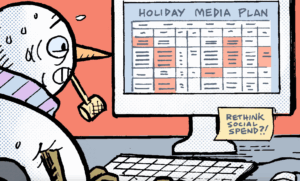 Full-service digital agency Primacy began in 1994 as Acsys Interactive. In 2012, it rebranded to emphasize its presence in digital. Also, prospects weren’t always clear how to pronounce Acsys. (It was “Access”, for the record.)
Full-service digital agency Primacy began in 1994 as Acsys Interactive. In 2012, it rebranded to emphasize its presence in digital. Also, prospects weren’t always clear how to pronounce Acsys. (It was “Access”, for the record.)
The agency, still independently owned by President Stan Valencis, has traditionally gotten traction via word of mouth.
“We get a small project with a client, we’d do a good job and they’d ask us to do a little more work and a little more,” said Craig Kallin, the agency’s SVP of business development and marketing.
Kallin described Primacy as a full-service agency (“Which I’m sure you hear a lot”), meaning it develops marketing strategies, insight through research, creative development and technical implementations for everything from websites to building applications that tie into back-end systems.
Primacy focuses on five key verticals, each with a practice lead: financial services, health care, consumer packaged goods, higher education and manufacturing. Its clients include EmblemHealth, The Hartford and Tufts Medical Center.
Kallin spoke with AdExchanger.
AdExchanger: What is the biggest misconception brands have around activating data?
CRAIG KALLIN: A lot of our customers purchase a digital marketing system (DMS) and think it’s just going to happen. [Ed: A DMS combines a content management system with the ability to syndicate content across multiple channels.] But there’s a lot of prework that’s needed in order for the system to do its job. You need to have that profile data and understand the attributes and map that content and special messaging to consumer profiles. You need to define the taxonomies and tag the content appropriately. That’s a lot of up-front work.
Can you give me an example?
We had an online school come to us and ask us to build out a responsive website. We did some research on their user and what we found is that their users don’t actually own a desktop at all. Few owned tablets and they all owned smartphones.
So we made it responsive so it could scale up, but we took a smartphone-out approach rather than a desktop-in.
They had no idea their visitors weren’t coming from desktops?
They had data that suggested visitors were mobile, but had some trouble delineating smartphone vs. tablet, for example. We helped them with that delineation and did some ancillary research within the client base that validated that assumption.
Do you ever run into issues with clients refusing to share certain data sets with you?
We don’t run into that one too frequently. The way we work, we try to find clients that are really a good fit from a relationship standpoint and who are looking for a long-term partner. We try to build that trust during the sales cycle. We do a good job showing case studies on why it’s important to have certain information. While we don’t need PII or customer-specific information, knowing what the aggregate information is and how it’s helped us in the past, like showing the case study around the online school, makes the lightbulb go on.
I’m not aware of a situation where a client has refused to share the data.
To what extent do you have data-related issues with clients?
Sometimes they don’t have the data or don’t know how to synthesize the data. There are often things we need to do to remedy that, like ad tags to their existing site, or benchmark, or when there are information gaps.
Where do those gaps normally occur, and how do you fill them?
I can’t say I’ve seen any particular trends.
We start to map the online experience to tasks. The work we’ve been doing for years, and we’re not the only ones, is around really understanding the customer profiles and building out the personas. We start with different archetypes, the main buckets of users that have common themes around them. Then we drill into individual users. Then we go into the journey maps, understanding what the overall buying cycle is and how digital supports them in that process.
Also what are the different device types they’ll have preference for? That might vary as they move along. In experience maps, we identify the key consumers and the high value tasks they do, and how to map those high-value tasks so we can identify weak points along the buying cycle and make sure we’re shoring things up.
Can you provide an example of drilling down into archetypes to find more individualized consumers?
We’re working with a bicycle manufacturer that’s focused primarily on the hardcore section – the folks that use bikes for racing. But they realize there’s opportunity in targeting more of the recreational folks.
There’s been movement in the marketplace where cycling became less of a recreation and more of a hardcore sport, specifically targeted to rich white men. Now, that was fine to a point. With baby boomers in the market place, there were enough rich white men to drive it forward. With Generation X, there are fewer of them.
When women pulled out of the marketplace, they brought the kids with them. So the population is increasing, but none of these kids were exposed to cycling because the mothers pulled them out when they went out.
What’s this client’s goal?
They want to tap back into that recreational market to attract both the women and the kids they bring with them. We created archetypes, one around hardcore cyclists and one around joy riders. Within any given archetype, there are multiple personas. You can be a hardcore road bike rider vs. a hardcore mountain bike rider, for instance.
All of the personas representing hardcore riders will have a lot of similarities and attributes much different from joy riders. Joy riders will have a lot of commonalities, such as whether safety is important, or they’re family riders, or they’re parents.
Rather than creating in-depth personas for every potential buyer, you can identify the main differences between large groups of archetypes and delineate what those differences are, then drill down into the personas.
How do you actually do this?
In this particular case, we went out and looked at third-party research, market-based research on the bike market specifically. That’s what helped us identify this trend around women leaving the marketplace. Then we worked to identify, within the market research we’re seeing, profiles around them through primary research with the folks we’ve identified in that category. Stakeholder interviews within the company itself. And really just fleshing it out based on third-party market data we’ve obtained, the primary research we did via survey, the interviews we’ve done, and fleshing out these profiles for the joy rider categories using the robust data we have on the hardcore category as a model.
Once you break down the joy rider archetype, what’s the next step? How do you find these people to message?
We develop a journey map that takes them along the continuum of the purchase cycle. This starts with the trigger event that puts them in the marketplace, to making a final purchase decision, to having them become advocates of the brand.
One continuum represents the buying cycle of both joy rider and the hardcore rider.
What’s different is the user journey in that continuum diverges at certain points and comes back at certain points. They may start out together with some of the trigger points, but as they start doing their research and how they conduct their research and how they make their decisions, there’s a divergence in that path between the two main archetypes.
So understanding how those different archetypes move through that continuum and what their journey looks like helps us identify what their pain points might be, what questions they’ll have along the way, how those questions will be different, where will they be online looking for information. Some will be looking at more cycle-oriented sites for information, others will be looking at family commuting sites for information.
That helps us build a good understanding of what the digital ecosystem looks like for these folks.
Do you handle media buying at all?
We do offer media-buying services for some of our customers. But often we go into an organization that has a long-term contract with a media agency, so we’ll earn the right to be part of the planning process and the campaign optimization process.
Often we find, depending on how big the agency is and where the client falls within that media agency, and I’m not accusing anyone of anything, but there is sometimes a set-it-and-forget-it mentality.
In what way?
The plan gets set, it goes through the sausage maker, the sausage maker spits out the media plan, they make the buy, provide updates that show how the campaign is going, but nobody makes tweaks throughout. So we get involved with clients from a planning perspective to make sure the plan is more customized and not driven by the networks the media agency has the best relationships with where they’ll find the best margin. We try to build around where we’re convinced we’ll find the right consumers we’ve identified.
And then we try to sit on the performance review meetings so we can make suggestions on what we might do to get the buyer to shift funds, to the extent that it’s possible, even if we’re not doing the buy ourselves.
Doesn’t that create conflict with the media agencies?
Yup. It can be a challenge. It depends on the strength of the relationship between the media agency and client. Oftentimes it’s not a lack of willingness, it’s a lack of focus on the client. If we can bring that focus to date and make recommendations, we haven’t had a lot of resistance on that front.
I don’t mean to be badmouthing media agencies. I have nothing against media agencies and everybody has different ranges of clients and priorities. We’re just saying that in cases where some clients don’t feel they’re getting the attention they would like from their media agency, we try to help with that.
That doesn’t happen all the time.














